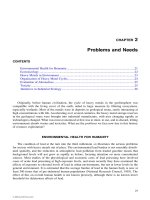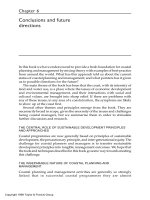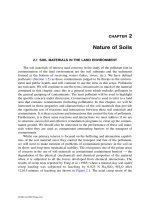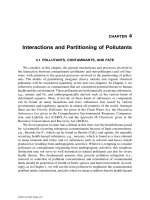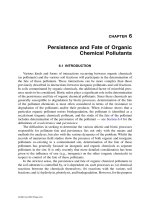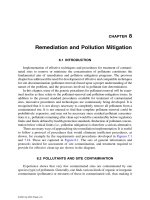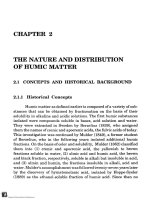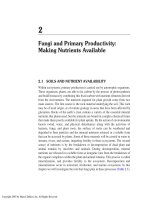Pesticide Residues in Coastal Tropical Ecosystems: Distribution, fate and effects - Chapter 2 ppsx
Bạn đang xem bản rút gọn của tài liệu. Xem và tải ngay bản đầy đủ của tài liệu tại đây (637.04 KB, 13 trang )
8 S. Osafo Acquaah and E FrempongChapter 2
Pesticides in the
marine environment of
Ghana
S. Osafo Acquaah and E. Frempong
INTRODUCTION
The Republic of Ghana – formed from the merger of the British colony of the
Gold Coast and the Togoland trust territory in 1957 – was the first country in
colonial Africa to gain its independence. It is located in western Africa roughly
between Lat. 5°N and 11°N, Long. 1°E and 3°30'W. It borders the Gulf of Guinea
in the south, Burkina Faso (Upper Volta) along its north and northwest border, the
Republic of Côte d’Ivoire in the west and the Togolese Republic (Togo) in the
east. Ghana has a total land area of 238,540 km
2
divided among 10 administrative
regions: Ashanti, Brong-Ahafo, Central, Eastern, Greater Accra, Northern, Upper
East, Upper West, Volta, and Western (Figure 2.1).
Ghana’s climate is warm and comparatively dry along the southeast coast but
hot and humid in the southwest and hot and dry in the north. There are two
distinct rainy seasons in the south: April to July and September to November;
however, in the north, the rainy seasons tend to merge lasting from April through
September. Annual rainfall ranges from about 1,100 mm in the north to about
2,100 mm in the southeast. The harmattan, a dry, northeasterly desert wind, blows
from December to March, lowering the humidity and creating hot days and cool
nights in the north. In the south the effects of the harmattan are felt primarily in
January.
A tropical rainforest belt, broken by heavily forested hills along with many
streams and rivers, extends northward from the Gulf of Guinea, near the Côte
d’Ivoire frontier. This area, known as the Ashanti, produces most of the country’s
cocoa, minerals, and timber. North of the rainforest, Ghana is covered by low
bush, park-like savanna, and grassy plains. Ghana’s dominant feature is 8,482 km
2
Lake Volta, which backs up behind Akosombo Dam on the Volta River, and is one
of the world’s largest artificially created lakes. This lake generates electricity,
provides inland transportation, and is a potentially valuable resource for irrigation
and fish farming in Ghana. It also provides an additional 1,125 km of arterial and
feeder waterways beyond the 168 km of perennial navigation – for launches and
© 2003 Milton D. Taylor, Stephen J. Klaine, Fernando P. Carvalho, Damia Barcelo and Jan Everaarts
Pesticides in the marine environment of Ghana 9
lighters – on the Volta, Ankobra, and Tano rivers. Ghana’s coastline stretches for
539 km along the Gulf of Guinea and is mostly a low, sandy shore backed by
plains and scrub. It is intersected by several rivers and streams, most of which are
navigable only by canoe.
The country is well endowed with natural resources, e.g. gold, timber, industrial
diamonds, bauxite, manganese, fish, rubber, and hydropower, and has twice the
per capita output of the poorer countries in West Africa. Gold, timber, and cocoa
production are its major sources of foreign exchange while the domestic economy
continues to revolve around subsistence agriculture. Agriculture, including natural
resource extraction, accounts for 47 percent of Ghana’s GDP and employs 54.7
percent of the work force, mainly small landholders. Ghana’s land use includes 12
percent in arable land, 7 percent in permanent crops, 22 percent in permanent
pastures and 35 percent in forests and woodlands with the remaining 24 percent in
other uses (1993 est.). There are also 60 km
2
of irrigated farmland (1993 est.). The
recent drought in the north has severely affected agricultural activities in that region.
However, throughout the country deforestation, overgrazing, soil erosion, poaching,
Figure 2.1 Map of Ghana showing the ten administrative regions and the marine coastline
on the Gulf of Guinea
© 2003 Milton D. Taylor, Stephen J. Klaine, Fernando P. Carvalho, Damia Barcelo and Jan Everaarts
10 S. Osafo Acquaah and E Frempong
and habitat destruction threaten wildlife populations. Water pollution and inade-
quate supplies of potable water also pose serious problems for the approximately
19.5 million inhabitants of Ghana.
Ghana is party to a number of international agreements affecting the environ-
ment including the Biodiversity, Climate Change, Desertification, Endangered
Species, Environmental Modification, Law of the Sea, Nuclear Test Ban, Ozone
Layer Protection, Ship Pollution, Tropical Timber 83, Tropical Timber 94, and
Wetlands agreements. Ghana has also signed but not yet ratified the Marine Life
Conservation agreement.
The effect of pesticides on public health and on the environment including the
tropical marine environment of Ghana are of special interest to the nation. The
marine environment of Ghana is polluted from a variety of sources: industrial
waste effluent of several industries, e.g. breweries, textile manufacturers, fish proces-
sors, paint manufacturers, poultry and livestock feedmills, cement manufacturing
companies, and oil refineries, located in the coastal industrial towns of Accra,
Tema, Sekondi, Takoradi, and Cape Coast; discharges from the inland Lake Volta
and the rivers Densu, Tano, Ankobra, and Pra; domestic sources such as sewage;
agricultural activities; mining; quarrying; and others.
In the past 15 years, there has been a growing interest and increased investment
in agriculture to boost food production in Ghana. This has led to increased use of
pesticides for the control or eradication of agricultural pests. Most of the pesticides
used for agricultural and other purposes are non-specific and can affect both target
and non-target organisms if they reach the marine ecosystems of Ghana. This
chapter presents the status of pesticide pollution in the tropical marine environment
of Ghana. Although some of the problems associated with the pollution of Ghana’s
marine environment have been recognized, very little research work has been done
to assess the magnitude of the pollution problem and the nature of the pollutants.
PESTICIDE LEGISLATION IN GHANA
For many years, there was no organization or agency responsible for regulating
the importation, manufacture, distribution, handling, and use of pesticides in
Ghana. Early attempts by some government organizations such as the Ministry of
Health, Ministry of Agriculture, and the Ghana Standards Board to control the
importation and distribution and use of pesticides in the country were not successful
due to lack of coordination and logistics. The Environmental Protection Council,
now referred to as the Environmental Protection Agency (EPA), was established in
1974 as an advisory and research organization to coordinate the activities of other
government bodies concerned with issues related to the environment. It adopted
procedures that required all importers and formulators of pesticides to seek
clearance for the importation of pesticides (Environmental Protection Council,
1991). In this regard, chemicals are screened by the agency before they are imported
into the country. The EPA is assisted and supported by the Ghana Standards Board
© 2003 Milton D. Taylor, Stephen J. Klaine, Fernando P. Carvalho, Damia Barcelo and Jan Everaarts
Pesticides in the marine environment of Ghana 11
(GSB), Ghana Customs, Excise and Preventive Services, Factories Inspectorate
Department, and the Plant Quarantine and Regulatory Services. This screening
provides a form of control over the industrial chemical trade within the country
and the importation of chemicals into the country.
In 1994, the EPA Act (Act 490) was promulgated and, eventually the Pesticide
Control and Management Bill (PCMB) was passed in 1996. The PCMB ensures
an effective monitoring of the importation, distribution, storage, sale, and use of
pesticides and other hazardous substances in the country. The Ghana Government
enacted the PCMB to protect farmers, consumers, and the environment from
harmful chemicals by ensuring quality in the manufacture of these chemicals and
judicious use of these substances (particularly pesticides). Through this PCMB,
the government hopes to ensure that end users are able to buy efficacious pesticides
and apply them to best advantage; protect pesticide applicators, handlers, and
those in contact with pesticides against the toxic effects of pesticides, especially
irreversible effects; protect the general population against hazardous residues in
foodstuffs; and protect the environment, especially non-target wildlife, against
undesirable effects or hazards from applied pesticides.
The legislation is divided into four parts and the essential provisions of each
part are as set out below. Part I addresses the registration of pesticides and provides
for the compulsory registration, by Ghana’s EPA, of all pesticides unless a pesticide
is exempted from registration under Clause 2. Under such circumstances an
unregistered pesticide may be imported for experimental or research purposes but
not for general distribution, imported in the event of a national emergency, or
imported only for purposes of a direct transhipment through Ghana (and it is
permitted for entry into the country of destination). Part I also outlines the method
for companies to apply for registration of pesticides and the mode and basis of
classification of pesticides. Pesticides are classified as restricted, suspended, or
banned and are subject to the ‘Prior Informed Consent Procedure’, which enables
the national pesticide law to be linked with internal regulations at the local district
and regional levels in order to meet obligations under international trade protocols
for control of pesticides and other chemical substances.
Ghana’s EPA may approve and register a pesticide under such conditions as it
may determine and may only register a pesticide if it is satisfied that the pesticide
is safe and effective for the use for which it is intended and that the pesticide has
been tested for efficacy and safety under local conditions. In addition, it has the
power to ban or suspend the registration of any pesticide or cancel the registration
where it is satisfied that the pesticide is not effective or may cause hazards to people,
animals, crops, or the environment (Environmental Protection Council, 1991).
There is also a provision for the provisional clearance of some pesticides, valid for
no more than two years, for use before registration under certain circumstances.
The EPA also has the authority to cancel such provisional clearance status.
Applicants are informed in writing of refusals to register a pesticide and the grounds
for the refusal. A pesticide registration remains valid for a period not exceeding
two years and is renewable subject to review. Ghana’s EPA maintains a registry of
© 2003 Milton D. Taylor, Stephen J. Klaine, Fernando P. Carvalho, Damia Barcelo and Jan Everaarts
12 S. Osafo Acquaah and E Frempong
pesticides with the names and particulars of registered and provisionally cleared
pesticides and publishes, annually, in the Gazette a list of registered pesticides, their
classification, and amendments made to their classifications.
Part II of the legislation sets forth requirements for the licensing of dealers in
pesticides, which are defined as importers, exporters-manufacturers, distributors,
advertisers, and sellers of pesticides. Dealers are required to obtained licenses as a
prerequisite for dealing in pesticides and to keep records of their activities, retain
them for 10 years, and make them available to the EPA when so required. The EPA
also sets out safeguards for the use of pesticides and has the power to restrict or
prohibit the use of a registered pesticide in designated areas within specified periods.
The legislation prescribes appropriate containers, packaging, and labels for
pesticides; stipulates that certain acts in relation to the adulteration of registered
pesticides are prohibited; sets forth certain standards for the chemical component
of registered pesticides; and prohibits the false advertisement of registered or
provisionally cleared pesticides. Furthermore, it establishes a Pesticides Technical
Committee of the GSB to perform pesticide control and management functions
under the Bill as directed by the Board.
Part III details the enforcement provisions of the PCMB and provides for
inspectors and persons authorized by District Assemblies to perform the functions
of properly implementing the provisions of this law. It also provides penalties for
failing to comply with provisions of the law.
The final part of this landmark legislation contains several general provisions
that enjoin customs officers to assist in enforcement, provided that the Minister for
the Environment in consultation with the Minister responsible for Food and
Agriculture makes regulations for the full implementation of the law, and allowed
a 6-month grace period for registration of pesticides and issuance of licenses before
sanctions could be imposed (Environmental Protection Council, 1991). Ghana’s
EPA is working with other appropriate bodies to establish the necessary machinery
for executing provisions of the law.
PESTICIDE USE IN GHANA
For the past several decades, pesticides have been used in Ghana in the public
health sector for disease vector control and in agriculture to control and eradicate
crop pests. However, there has been a rapid rise in the quantity of pesticides used
in agriculture over the past ten years and this growth trend is expected to continue
for the next ten or more years. Agricultural pesticides are used in the cocoa growing
industry (cacao tree cultivars from the genus Theobroma), for cotton farming, in
vegetable production, and for other mixed-crop farming systems involving maize,
cassava (perennial shrubs of the genus Manihot grown for the edible tubers), cowpeas
(the vine-like herb Vigna unguiculata L. grown for its edible seeds), sugarcane, rice,
etc. The majority of pesticides used in agriculture are employed in the forest region
located in the Ashanti, Brong Ahafo, western, and eastern regions of Ghana.
© 2003 Milton D. Taylor, Stephen J. Klaine, Fernando P. Carvalho, Damia Barcelo and Jan Everaarts
Pesticides in the marine environment of Ghana 13
Organochlorine pesticides are widely used by farmers because of their cost effective-
ness and their broad spectrum activity. Lindane is widely used in Ghana on cocoa
plantations, on vegetable farms, and for the control of stemborers in maize (Ministry
of Agriculture, 1990). Endosulfan is widely used in cotton growing areas, on
vegetable farms, and on coffee plantations. Most of the farms in Ghana’s vegetable
growing areas are situated along rivers that also serve as the water supply source
for farming and for drinking water.
Pesticides are also employed to control ectoparasites of farm animals in Ghana.
In a study encompassing 30 organized farms and 110 kraals distributed throughout
the 10 regions of Ghana, Awumbila and Bokuma (1994) found that 20 different
pesticides were in use with the OC lindane being the most widely distributed and
used pesticide, accounting for 35 percent of those used on farms and 85 percent
of those used by herdsmen. Of the 20 pesticides, 45 percent were OPs, 30 percent
were pyrethroids, 15 percent were carbamates, and 10 percent were OCs (Awumbila
and Bokuma, 1994). The favorite method of application was by hand dressing
and no post application interval was used before slaughter or sale of milk for
human consumption (Awumbila, 1996). In this regard, there is the potential for
significant risk to human health, both for the applicators and the end-users of
agricultural products. Clarke et al. (1997) studied the knowledge, attitudes, and
practices of 123 farm workers on three irrigation project areas in the Accra Plains
regarding the safe handling and use of pesticides. They found moderate levels of
knowledge of pesticide absorption routes and of potential symptoms following
exposure. However, farm workers’ knowledge of personal protective measures was
poor to moderate and their use of personal protective equipment was minimal –
due primarily to financial constraints. They concluded that training of agriculture
and health workers in safety precautions, recognition, and management of pesticide
poisoning was a matter of urgency.
In the public health arena, pesticides, primarily temephos (Osei-Atweneboana
et al., 2001), have been used by the Onchocerciasis Programme in the Volta Basin
for control of black flies (Simulium spp. Diptera: Simuliidae), which transmit Oncho-
cerciasis (African river blindness, a disease caused by the pathogenic nematode,
Onchocerca volvulus) to humans and for control of domestic pests, e.g. cockroaches,
various flies, mosquitoes, ectoparasites including ticks, and other insects. Blindness
caused by Onchocerciasis is a serious and ongoing problem in this region of Africa
such that the systematic treatment of most rivers across West Africa is likely to
continue for the foreseeable future. However, Osei-Atweneboana et al. (2001) have
found evidence for mild resistance development (slight to five-fold) to temephos in
black fly populations from two sites in south-west Ghana – Sutri Rapids on the
Tano River and Sekyere-Heman on the Pra River – where the larvicide had not
been applied. They speculate that the likely cause of resistance could have been
local selection of black flies exposed to agrochemical runoff from cocoa, coffee,
and palm oil plantations flanking the rivers.
No detailed records have been kept on the volume and types of pesticides used
in the country, except for a few chemicals. However, analysis of pesticide trade
© 2003 Milton D. Taylor, Stephen J. Klaine, Fernando P. Carvalho, Damia Barcelo and Jan Everaarts
14 S. Osafo Acquaah and E Frempong
flow patterns, recorded by Ghana’s Statistical Service, between Ghana and other
countries for the period January to December 1992 and January to June 1993
indicate a total of 2,589,254 kg and 1,264,872 kg of pesticides respectively, were
imported during this period (Boateng, 1993a; 1993b). Analysis of external trade
statistics compiled from custom bills of entry completed by importers and exporters
or their agents show that pesticides are mostly imported rather than exported in
Ghana.
Analysis of the data available for the period January to December 1992 showed
the following distribution of the various types of pesticides: insecticides (60.8
percent), herbicides (24.2 percent), fungicides (8.9 percent), rodenticides (1.5
percent), and other pesticide types (4.6 percent) (Boateng, 1993a). A survey
conducted between 1992 and 1994 found that the following pesticides are most
commonly used by farmers (in percentage of farmers using a pesticide): copper
(II) hydroxide (kocide) 29.0 percent, mancozeb (dithane) 11.0 percent, fenitrothion
(sumithion) 6.0 percent, dimethoate (perfekthion) 11.0 percent, pirimiphos methyl
(actellic) 11.0 percent, λ-cyhalothrin (karate) 22.0 percent, and endosulfan (thiodan)
10.0 percent. Lindane is widely distributed by the Ministry of Agriculture and was
not included in the survey. The study also indicated that insecticides constitute
about 67 percent of pesticides used by farmers while fungicides made up about 30
percent and herbicides and other pesticide types were about 3 percent of total use
(Osafa Acquaah and Frempong, 1995). Table 2.1 lists some of the pesticides used
in agriculture in Ghana based on a survey conducted from 1992 to 1994 in the
Ashanti, Brong Ahafo, eastern, and western regions of Ghana.
PESTICIDE RESIDUES IN BIOTA AND NON
BIOTIC MATRICES IN THE INLAND, COASTAL,
AND MARINE ECOSYSTEMS OF GHANA
OC residues in the interior of Ghana
Osafo Acquaah (1997) measured lindane and endosulfan in river water and fish
tissues collected from rivers passing through regions of intense cocoa production
and other farming activities in the Ashanti Region between 1993 and 1995. Water
and fish samples from 1995 contained both lindane and endosulfan – these were
the only two pesticides being investigated but chromatogram peaks corresponding
to the DDTs and other OCs were observed – with much lower levels of both
pesticides present in water samples. For the Oda, Kowire, and Atwetwe rivers,
mean concentrations found in water samples for lindane and endosulfan were
19.4, 12.4, 16.4 and 17.9, 20.5, and 21.4 ng L
–1
, respectively (Osafo Acquaah,
1997). Concentrations in all the fish varied by species and month of sampling but
were generally higher for lindane and much higher for endosulfan.
Ntow (2001) measured OC pesticide residues in water; sediment; the tomato
crop, which constitutes more than 90 percent of the major vegetables grown in the
© 2003 Milton D. Taylor, Stephen J. Klaine, Fernando P. Carvalho, Damia Barcelo and Jan Everaarts
Pesticides in the marine environment of Ghana 15
Table 2.1 Trade names of agrochemicals, classified by use, used by farmers from the
Ashanti, Brong Ahafo, eastern, and western regions of Ghana
Insecticide Herbicide Fungicide Other
Actellic (primiphos Gesaprim Baygon Grofol
methyl)
a
(atrazine) (propoxur) (foliar 20-30-10 NPK
+ micronutrients)
Cymbush Bellater (atrazine Caacobre Pracol
(cypermethrin) + cyanazine) (copper (II) oxide) (ampicillin trihydrate
–antibacterial)
Desis (deltamethrin) Garlon (triclopyr, Champion (copper
a pyridine (II) hydroxide)
herbicide)
Diazinon Gramoxone Cobox (copper
(paraquat) oxychloride)
Dimethoate 40 EC Ronstar Dithane
(oxadiazon) (mancozeb)
Dursban (chlorpyrifos) Roundup Kocide
(glyphosate) (copper (II)
hydroxide)
Endosulfan Stam F34T Gastoxin
(propanil) (aluminum
phosphide)
Fenitrothion Basta 20 SL
(glufosinate)
Fenom C (profenophos Sturnmate
+ cypermethrin) (thiobencarb)
Primigram (metolachlor
+ atrazine) Bladex (cyanazine)
Nogos (dichlorvos) Bladex (cyanazine)
Ofunack
(pyridiphenthion)
Perfekthion
(dimethoate)
Phostoxin (aluminium
phosphide)
Ripcord (cypermethrin)
Secto (lindane +
synergized pyrethroids)
Sumithion (fenitrothion)
Thiodan (endosulfan)
Trebon (etofenprox)
Gammalin 20 (lindane)
Callifan 50CE
(endosulfan)
Furadan (carbofuran)
Unden (propoxur)
Karate (λ-cyhalothrin)
Totals 24 10 7 2
Note:
a Common names for a.i.(s) of commercial products are given in parenthesis where known.
© 2003 Milton D. Taylor, Stephen J. Klaine, Fernando P. Carvalho, Damia Barcelo and Jan Everaarts
16 S. Osafo Acquaah and E Frempong
district; and human fluids – blood samples and mothers’ breast milk – for 208
samples collected from the environs of Akumadan, a vegetable farming community
located 95 km northwest of Kumasi in the Ashanti Region. Aldrin, dieldrin, endrin,
2,3,5-TCB, p,p´-DDD, and p,p´-DDT were not detected in any of the samples.
However, endosulfan sulfate, α-endosulfan, β-endosulfan, and lindane were detected
in water samples taken from four area streams and a community standpipe at
mean levels (frequency of detection in parentheses) of 30.8 ng L
–1
(78 percent),
62.3 ng L
–1
(60 percent), 31.4 ng L
–1
(60 percent), and 9.5 ng L
–1
(76 percent),
respectively (Table 2.2). Sediment samples from the four streams contained all
seven OCs, each appearing in 88 percent or more of the samples analyzed. Lindane
was detected at the highest level (3.2 µg kg
–1
) followed by HCB (0.9 µg kg
–1
),
heptachlor epoxide (0.63 µg kg
–1
), and p,p´-DDE (0.46 µg kg
–1
). HCB and p,p´-
DDE were the only OCs detected in blood and milk and both were at lower levels
in milk than those reported in industrialized countries. Ntow (2001) estimated the
daily intake of DDE and HCB by nursing infants and found that consumption of
both pesticides were below WHO/UNEP acceptable daily intakes.
The Ghanaian coastline
The Ghanaian coastal zone is a part of the coastal area of the Gulf of Guinea and
is subject to some level of erosion. The degree of erosion depends on the location
and geology of the area of concern. The coastal zone, especially around the ports
of Accra, Tema, and Takoradi, has been the major area of industrial development
in Ghana. Almost 60 percent of all industries in the country are located in the
Accra-Tema metropolis, which covers less than 1 percent of the total area of Ghana.
Along the entire coastline of Ghana, discharges into the environment are, to a
large extent, untreated and unregulated, thus increasing the risk of pollution and
modification to the marine environment especially in areas of high population
density (Calamari, 1985; Calamari and Naeve, 1994).
The marine area of Ghana
The marine area of Ghana covers about 203,720 km
2
based on the 550 km stretch
of Ghana’s coastline and encompasses the area between the landward low-water
mark of the coastal zone and the seaward boundary of the 200 nautical mile
Exclusive Economic Zone, which is 370.4 km from shore. This area is equivalent
to 85 percent of the total land area of the country.
Impact of inland drainage and land-based
pollution sources on coastal lands and waters
The Volta River system which, apart from its large tributaries, includes Volta Lake
and the Kpong Headpond is the dominant inland drainage system in Ghana.
Some other major rivers, including the Tano, Ankobra, Pra, and Densu, also drain
into the sea through coastal lagoons and estuaries. These rivers may carry pollutants
© 2003 Milton D. Taylor, Stephen J. Klaine, Fernando P. Carvalho, Damia Barcelo and Jan Everaarts
Pesticides in the marine environment of Ghana 17
Table 2.2 Organochlorine pesticide residues in water, sediment, tomato, and human fluids in a vegetable farming community located in the
Ashanti Region of Ghana
Pesticide Water Sediment Tomato Blood Milk
ng L
–1
% of
µ
g kg
–1
dw
a
% of
µ
g kg
–1
fw
b
% of
µ
g kg
–1
% of
µ
g kg
–1
% of
samples samples samples samples samples
HCB BD
c
10 0.90 90.5 <0.10
d
51.3 30 55 1.75 95
Lindane 9.5 76 3.20 95.2 <2.50 23.7 ND
e
0ND0
p,p´-DDE BD 8 0.46 88.1 <0.10 7.9 380 85 17.15 80
Heptachloor epoxide BD 12 0.63 97.6 1.65 55.3 ND 0 ND 0
α-endosulfan 62.3 64 0.19 95.2 <0.05 23.7 ND 0 ND 0
β-endosulfan 31.4 60 0.13 88.1 <0.01 11.8 ND 0 ND 0
Endosulfan sulfate 30.8 78 0.23 97.6 <0.01 35.5 ND 0 ND 0
Source: Adapted from Ntow, 2001.
Notes:
a dw indicates dry weight.
b fw indicates fresh weight.
c BD indicates compound detected but below detection limit of 100 ng L
–1
.
d (<) indicates compound detected but below detection limits.
e ND indicates compound not detected.
© 2003 Milton D. Taylor, Stephen J. Klaine, Fernando P. Carvalho, Damia Barcelo and Jan Everaarts
18 S. Osafo Acquaah and E Frempong
originating from point sources such as municipal sewers and industrial discharges
into the coastal zone. The principal sources of land-based pollution are municipal,
industrial, and agricultural discharges, which are usually untreated and unregulated.
Agricultural practices contribute to the release of pollutants, mainly pesticides
and fertilizers, into the coastal zone through land runoff, river loading, and
atmospheric transport. In drainage basins, where the levels of pollutants such as
pesticides, trace metals, and nutrients are high as a result of industrial, agricultural,
or domestic activities, the continuous discharge of such surface waters may cause
localized pollution of coastal environments, especially in lagoons and estuaries.
Marine pollution and pesticide residue
research
Within the framework of the United Nations Environmental Program (UNEP)
Regional Seas Program, four action plans covering African countries have been
signed. The action plans covering West and Central Africa, of which Ghana is a
part, comprise projects on marine pollution monitoring and research with
components for analysis of metals and OCs in biota; oil pollution monitoring on
beaches and in coastal waters; and bacteriological quality control of bathing waters
(UNEP, 1985).
Many chlorinated insecticides, e.g. DDT, aldrin, dieldrin, and endosulfan, have
been used in Ghana for more than three decades in agriculture, vector control,
and other facets of public health. So far, however, no studies have looked for the
presence of OCs in biota. Biney (1982) identified the main sources of pollution of
the coastal environment of Ghana as sewage of both industrial and domestic origin
and oil, in the form of tar balls. Of the 16 lagoons he investigated, 12 were found
to be polluted and two were grossly polluted. The grossly polluted lagoons, the
Korle and Chemu estuaries, receive both industrial and domestic wastes. The
estuaries were generally slightly polluted. The major problem along the beaches
was pollution by domestic sewage including refuse. Sewage pollution of beaches
was found to be commonly associated with ‘high’ population areas including the
urban centers of Accra, Tema, Cape Coast, and Takoradi.
RECOMMENDATIONS
In view of the paucity of studies on OCs in biota, the following recommendations
are made:
Policy
1 Existing legislation, regulations, and standards concerning the marine environ-
ment and the coastal zone must be enforced. There is a need to strengthen
and broaden the current role of the Environmental Protection Agency to ensure
enforcement of existing laws.
© 2003 Milton D. Taylor, Stephen J. Klaine, Fernando P. Carvalho, Damia Barcelo and Jan Everaarts
Pesticides in the marine environment of Ghana 19
2 The legal regime for the protection of the marine environment must be further
developed. Comprehensive laws dealing with pollution of surface and
underground waters by pesticides must be enacted. Environmental impact
assessments of proposed projects in Ghana must be given due consideration.
Research
1 Studies should be carried out on the extent and effect of pollution with parti-
cular attention to pesticides in marine and coastal environments. The objective
would be to collect sufficient data to properly develop and manage the marine
environment. This would include measuring the level of contaminants,
studying contaminant accumulation that might lead to biological impacts,
and recording baseline data on the distribution of flora and fauna on beaches,
in coastal lagoons and estuaries, and in other near-shore ecosystems.
2 Conduct studies on the impact of inland drainage and land-based pollution
sources on coastal lands and waters. The objective would be to develop the
scientific basis for legislative provisions for appropriate abatement and control
measures. These studies should include the characterization of industrial
effluent to identify the most hazardous pollutants that would require immediate
control measures to be implemented, an estimation of the rate of input of
pollutants into the coastal zone from land-based sources, the distribution path-
ways of pollutants in coastal waters, and long-term studies on the biological
impact of pollution discharges into the coastal zone.
Education
1 Training programs should be established to increase public education on sound
environmental practices. Furthermore, agricultural management practices that
minimize excessive use of pesticides and chemical fertilizers should be
developed and instituted. Training programs for pesticide handlers and
applicators should be implemented.
2 The training of more environmental scientists and managers, both locally
and overseas, should be accelerated.
Monitoring
An effective monitoring system must be established to monitor estuarine and marine
pesticide levels, oil pollution, industrial and sewage pollution, and to conduct
research including analysis for metals and OC pesticides in biota. Additionally,
pollution monitoring of beaches and coastal waters should be instituted and
bacteriological quality control of bathing waters should begin.
© 2003 Milton D. Taylor, Stephen J. Klaine, Fernando P. Carvalho, Damia Barcelo and Jan Everaarts
20 S. Osafo Acquaah and E Frempong
Management
Relevant institutions must be strengthened and restructured through provisions
for skilled staff, state-of-the-art equipment, and logistical support, as necessary.
This would ensure reliable data gathering, standard setting, and monitoring as
well as effective execution and delivery of environmental projects and programs.
REFERENCES
Awumbila, B. 1996. Acaricides in tick control in Ghana and methods of application. Tropical
Animal Health and Production 28(2):S50–S52.
Awumbila, B. and Bokuma, E. 1994. Survey of pesticides used in the control of ectoparasites
of farm animals in Ghana. Tropical Animal Health and Production 26(1):7–12.
Biney, C. 1982. Preliminary survey on the state of pollution of the coastal environment of
Ghana. Oceanal Acta. 4(suppl.).
Boateng, O. 1993a. External Trade Statistics January–December 1992. Accra, Ghana:
Statistical Services, pp. 116–77.
Boateng, O. 1993b. External Trade Statistics January–June 1993. Accra, Ghana: Statistical
Services, pp. 79–80.
Calamari, D. and Naeve, H. (eds) 1994. Review of pollution in the African aquatic environ-
ment. Committee on Inland Fisheries Association (CIFA) Technical Paper 25. Rome: FAO.
Calamari, D. 1985. Review of the state of aquatic pollution of west and central African
inland waters. Committee on Inland Fisheries Association (CIFA) Occasional Papers 12:25.
Clarke, E.E.K., Levy, L.S., Spurgeon, A. and Calvert, I.A. 1997. The problems associated
with pesticide use by irrigation workers in Ghana. Occup Med Oxf. 47(5):301–8.
Environmental Protection Council. 1991. Ghana environmental action plan, Volume1. Accra,
Ghana: Environmental Protection Council.
Ministry of Agriculture. 1990. Technical Bulletin GDB/MI. Accra, Ghana: Ministry of
Agriculture.
Ntow, W.J. 2001. Organochlorine pesticides in water, sediment, crops, and human fluids
in a farming community in Ghana. Arch Envir Contam Toxicol. 40(4):557–63.
Osafo Acquaah, S and Frempong E. 1995. Organochlorine Insecticides in African Agroecosystems.
Vienna: IAEA. IAEA TECDOC-931, pp. 111–18.
Osafo Acquaah, S. 1997. Lindane and endosulfan residues in water and fish in the Ashanti
Region of Ghana. In: Environmental Behaviour of Crop Protection Chemicals. Proceedings of
a symposium held 1–5 July 1996 in Vienna by the IAEA/FAO. Vienna, Austria: IAEA,
pp. 471–8.
Osei-Atweneboana, M.Y., Wilson, M.D., Post, R.J. and Boakye, D.A. 2001. Temephos-
resistant larvae of Simulium sanctipauli associated with a distinctive new chromosome
inversion in untreated rivers of south-western Ghana. Medical and Veterinary Entomology
15(1):113–16.
UNEP. 1985. Industry and environment: Agrochemicals and their impact on the environ-
ment. UNEP Technical Publications 8(3) July/August/September.
© 2003 Milton D. Taylor, Stephen J. Klaine, Fernando P. Carvalho, Damia Barcelo and Jan Everaarts
